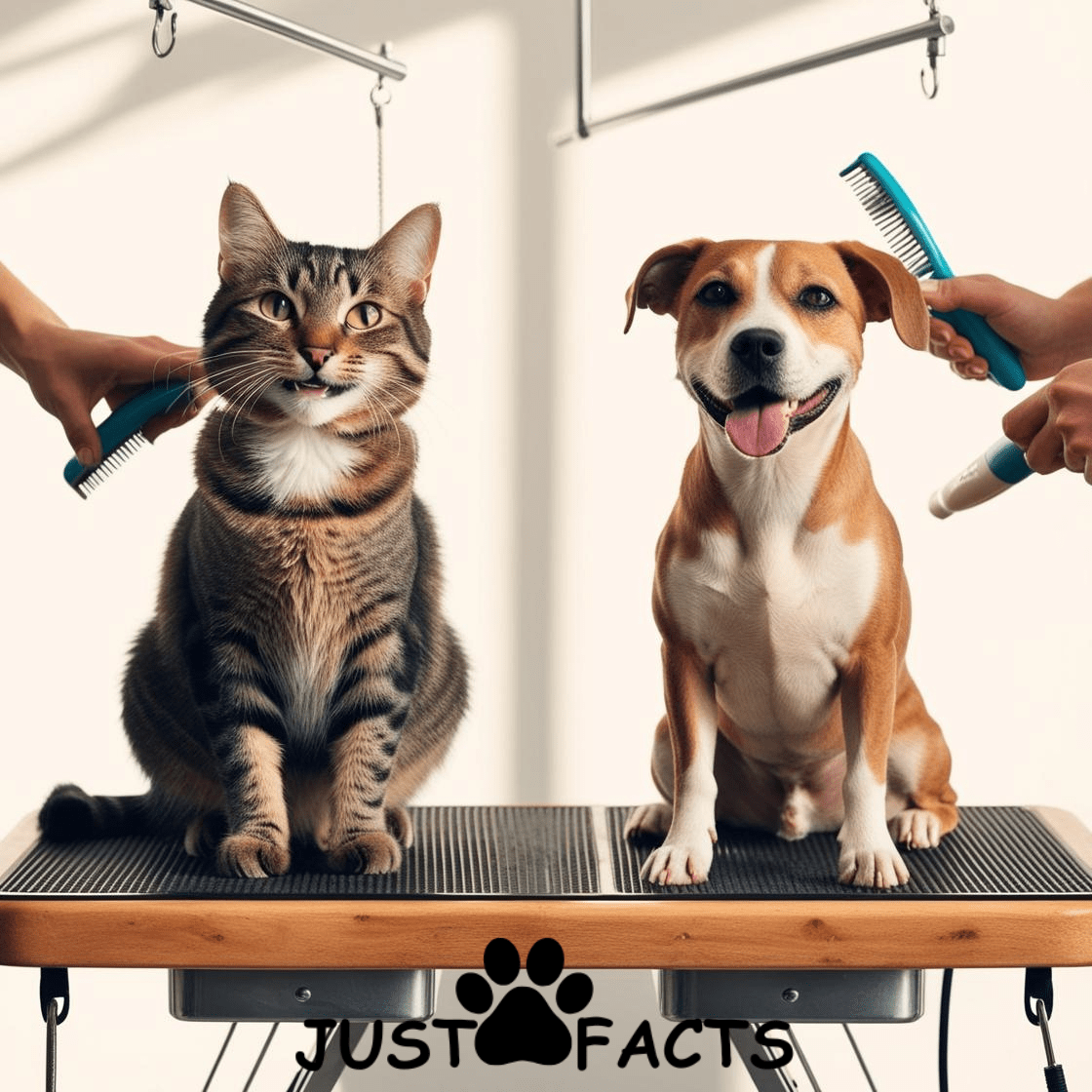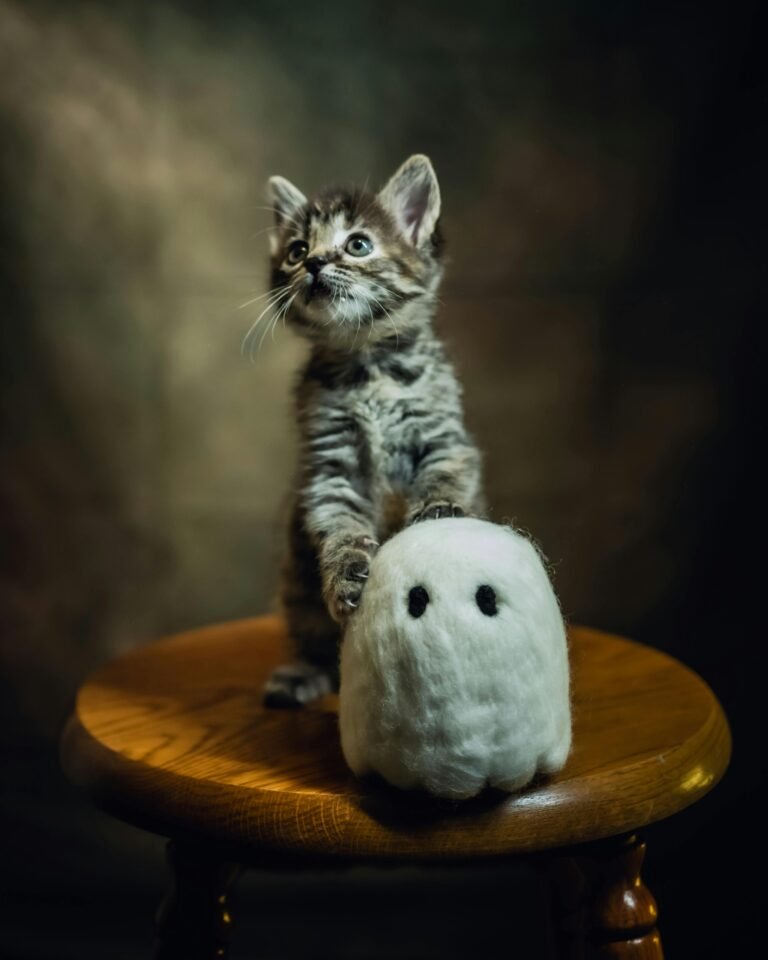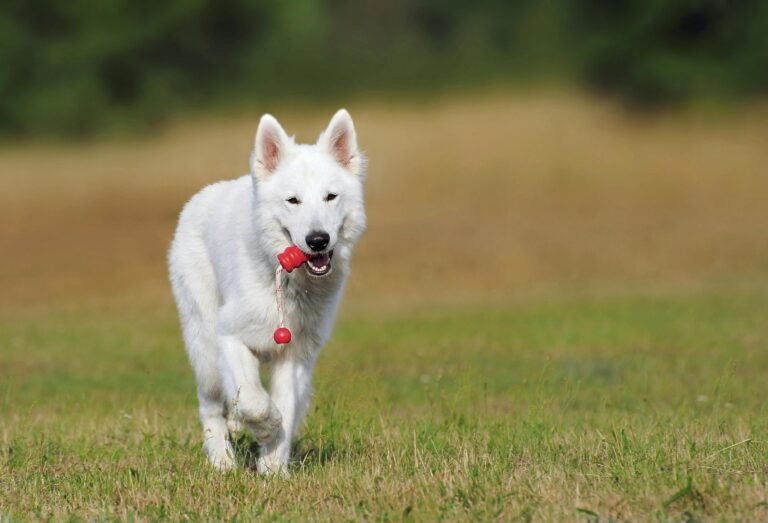Grooming is an essential aspect of pet care that extends beyond mere aesthetics; it plays a crucial role in maintaining the health and well-being of dogs and cats. Regular grooming not only enhances the appearance of pets but also promotes overall hygiene, contributing to their physical and emotional health. By incorporating grooming into a pet care routine, pet owners can significantly minimize health issues that may arise due to neglect.
This post may contain affiliate links. By purchasing through these links, you help support Just Paw Facts. Thank you for your support!

Benefits Of Pet Grooming
One of the primary benefits of grooming is the maintenance of a pet’s skin and coat. Regular brushing helps to remove loose hair, dirt, and dander, ensuring that the coat remains clean and free from matting. This is especially important for long-haired breeds, which are prone to tangles.
Brushing stimulates the skin’s natural oils, promoting a healthy, shiny coat. In contrast, neglecting grooming can lead to skin conditions, including infections and irritated skin. Moreover, dog grooming and cat grooming play a vital role in identifying abnormalities early, such as lumps, bumps, or signs of parasites.
Nail trimming is another crucial element of grooming that often goes overlooked. Overgrown nails can cause discomfort and pain, hindering a pet’s mobility and leading to potential joint issues. By keeping nails trimmed, pet owners can help maintain their furry friends’ physical comfort and mobility, enhancing their quality of life.
Routine grooming sessions can also act as a bonding experience between the pet and owner. These interactions provide an opportunity for pet owners to check on their animals’ well-being, build trust, and reduce the anxiety often associated with veterinary visits. Read How to socialize your pet.
Understanding Your Pet’s Coat Type
When it comes to pet grooming, understanding your pet’s coat type is crucial for effective maintenance of their hygiene and appearance. Dogs and cats can have a variety of coat types, including short, long, curly, and wiry, each requiring unique grooming approaches and tools to keep them healthy and clean.
Short-haired breeds, such as Beagles and Dalmatians, typically require less intensive grooming. A simple brushing once a week can suffice to remove loose hair and distribute natural oils throughout their coat. For cats, breeds like the American Shorthair also benefit from the occasional brush, which aids in pet hair removal and prevents hairballs.
On the other hand, long-haired pets, such as Afghan Hounds or Persians, necessitate a more frequent grooming routine. Regular brushing, ideally several times a week, is essential for preventing tangles and matting while promoting optimal pet hygiene. Tools like slicker brushes or combs work well for these coat types, ensuring that the coat remains free of dirt and debris.
Curly-haired breeds, such as Poodles and some cats, may require special care to manage their unique texture. These coats often need frequent trimming to maintain their shape and help control shedding. Specialized grooming tools designed for curly coats, like dematting combs, can make the grooming process smoother and more effective.
Wiry coats, seen in breeds like the Airedale Terrier, often demand unique grooming techniques. Hand-stripping, a method that involves plucking out dead hairs, is typically recommended to maintain the coat’s texture and appearance. Understanding these varying coat types enhances pet care, allowing owners to provide appropriate grooming that caters to their pet’s specific needs.
Essential Grooming Tools
When it comes to maintaining the hygiene and overall health of your pets, having the right grooming tools is crucial. Both dog grooming and cat grooming require specific equipment to effectively manage your pet’s fur and skin condition. Here are some essential tools every pet owner should consider having in their grooming arsenal. Read Top 5 Eco-Friendly Products For Pets.
Pet Grooming Brushes And Combs
Brushes and combs are indispensable. For dogs and cats with long or thick fur, a slicker brush is ideal for untangling knots and preventing matting. On the other hand, a bristle brush works well for short-haired pets by distributing natural oils across the coat, promoting pet hygiene. Using a metal comb can help in addressing any tangles and assessing skin conditions.
Clippers
Clippers are vital for trimming pet hair, especially for breeds that require regular haircuts. Opt for clippers that come with adjustable blade settings to suit different coat lengths. For routine grooming, selecting clippers specifically designed for pets ensures the process is smooth and comfortable for your animals.
Nail Trimmers
Nail trimmers are essential for maintaining your pet’s paw health. Regular nail clipping prevents discomfort and potential injuries during walks. Consider using a guillotine-style clipper for small pets and a larger version for bigger breeds. Ensure proper technique to avoid cutting into the nail too deeply, which can lead to bleeding.
Shampoo
Choosing the right shampoo is paramount for your pet grooming routine. Select a gentle formula that caters to your dog or cat’s specific skin needs, particularly if they have allergies or sensitivities. Understanding how to bathe a dog or cat effectively can help solidify a positive grooming experience. Proper care, combined with the right tools, ensures your pet remains clean, healthy, and happy.
Bathing Your Pet: Frequency and Techniques
Maintaining pet hygiene is essential for the overall well-being of your dog or cat. The frequency of bathing your pet significantly depends on its breed, age, lifestyle, and specific skin conditions. Generally, dogs require a bath every one to three months, while cats are often sufficiently clean without regular bathing due to their grooming habits. But, pets exposed to dirt, allergens, or excessive oil may necessitate more frequent baths.
When bathing your dog or cat, there are several techniques to ensure a positive experience. Start by gathering all necessary supplies, including a pet-specific shampoo, towels, a non-slip mat, and a detachable showerhead or cup for rinsing. For dogs, it’s advisable to brush their fur beforehand to remove loose hair and tangles. For cats, ensure to use a comfortable environment and minimize stress during this process.
Begin by wetting your pet’s coat slowly, from their neck down to avoid startling them. Apply a small amount of pet-safe shampoo, working it through the fur gently. Ensure that you’re avoiding sensitive areas, such as their eyes and ears. For sensitive skin, opt for hypoallergenic shampoos designed for pet grooming. Rinse thoroughly to ensure no shampoo residue remains, as this can irritate your pet’s skin.
After the bath, gently towel-dry your pet or use a pet-safe blow dryer on the lowest setting if your pet is comfortable with it. To enhance the grooming experience, provide treats and praise throughout the process, making it more enjoyable for your pet. Avoid common mistakes like using human shampoo or bathing too frequently, which can lead to skin irritation.
Brushing and Detangling
Regular brushing is a crucial aspect of pet grooming that promotes better pet hygiene and overall health for both dogs and cats. Through consistent brushing, pet owners can keep their furry companions’ coats healthy while minimizing shedding. The frequency of brushing largely depends on the type of coat—short-haired breeds may require brushing once a week, while long-haired breeds may need attention every few days to eliminate tangles and mats effectively.
When it comes to brushing different coat types, it is essential to choose the right tools. For short-haired pets, a bristle brush or a rubber curry brush works well to remove loose hair and dirt. For long-haired pets, a wide-toothed comb or a slicker brush is recommended for detangling knots and removing debris. Always start at the base of the hair and work your way up, using gentle strokes to avoid hurting your pet’s skin. For dogs and cats that are prone to mats, it is advisable to carefully cut away significant tangles with pet-safe scissors before brushing them out to prevent pulling on the skin.
To manage knots or mats, it is important to employ specific techniques. Gently holding the base of the mat close to the skin can help reduce discomfort while you work through it with a comb or brush. Using a detangling spray can also ease the process, making the fur easier to brush through. Keep in mind to frequently reward your pet during the brushing process to create a positive grooming experience. Incorporating these pet grooming strategies into your routine enhances pet care, ensuring a healthier coat, improved pet hygiene, and reduced shedding in your beloved companions.
Nail Clipping: Importance and Techniques
Nail clipping is an essential aspect of pet grooming that significantly impacts the health and comfort of both dogs and cats. Overgrown nails can lead to various health issues, including pain while walking, misalignment of joints, and even infections. Regular nail trimming can prevent these complications, ensuring that your pets remain active and comfortable.
To effectively clip your pet’s nails, a few tools are indispensable. Nail clippers specifically designed for pets, either guillotine or scissor types, are recommended for safe and effective trimming. Additionally, a nail file or grinder can smooth out the edges, preventing the nails from snagging on surfaces. It is also beneficial to have styptic powder on hand to quickly address any accidental nail bleeding, which can occur if the quick, a sensitive area within the nail, is nicked.
When it comes to calming anxious pets during the nail clipping process, patience and positive reinforcement are key. Begin by allowing your pet to become familiar with the nail clippers. Offering treats and praise during this introduction can help create a positive association. When you begin the actual clipping, start slowly, only trimming a small portion of the nail at a time. This gradual approach helps to reduce stress and builds trust between you and your pet.
Creating a comfortable environment is crucial. Choose a quiet space free of distractions, where your pet feels secure. If your pet is particularly anxious, consider a grooming restraint harness or towel to keep them still. Holding their paw gently but securely without causing discomfort can ease the experience. Engaging with your pet in a calm and reassuring manner will further enhance their comfort during the nail-clipping session.
Ear and Eye Care
Proper ear and eye care is essential for maintaining the overall health and hygiene of your pets. Dogs and cats are susceptible to a variety of ear and eye issues that can affect their well-being. It is crucial for pet owners to understand common signs of problems and the proper cleaning techniques to prevent such issues. Regular examinations of your pet’s ears and eyes can alert you to any potential concerns before they escalate.
For ear care, pet owners should be vigilant for signs of discomfort or infection, such as excessive scratching, head shaking, or a foul odor emanating from the ears. These symptoms may indicate an ear infection, which can be caused by bacteria, yeast, or even allergies. To clean your pet’s ears, use a vet-approved ear cleaner and a cotton ball. Gently wipe the outer ear canal and avoid inserting anything deep into the ear which could cause injury. Regular cleaning can help prevent the buildup of wax and debris, thereby maintaining good ear hygiene.
Eye care is equally important, as pets can suffer from tear stains, dry eyes, or conjunctivitis. Pet owners should routinely check their pets’ eyes for any redness, discharge, or excessive tearing. If you notice any abnormalities, it is advisable to consult a veterinarian for a proper diagnosis. To clean your pet’s eyes, use a soft, damp cloth to wipe away any discharge, being careful not to create further irritation. Keeping the fur around the eyes trimmed can also reduce the occurrence of tear staining, especially in breeds prone to such conditions.
Dental Hygiene: Keeping Your Pet’s Smile Bright
Dental hygiene is an often overlooked but critical aspect of pet care that contributes significantly to the overall health of dogs and cats. Just like humans, pets are susceptible to plaque and tartar buildup, which can lead to serious health issues if left untreated. Poor dental hygiene can result in gum disease, tooth loss, and even systemic infections that may affect vital organs. Therefore, maintaining optimal oral health is essential for your furry friend’s well-being.
One of the best ways to prevent dental issues is by routinely brushing your pet’s teeth. It is advisable to get your pet accustomed to having their teeth brushed from a young age. Use toothpaste specifically designed for dogs or cats, as human toothpaste can be harmful to pets. A soft-bristled toothbrush or finger brush can be effective in ensuring a comfortable brushing experience. Aim to brush your pet’s teeth at least two to three times a week for optimal results.
In addition to regular brushing, incorporating dental treats and chew toys into your pet’s routine can aid in maintaining oral health. Many pet owners find success with dental chews that are designed to reduce plaque and tartar buildup while also providing a satisfying chewing experience. Select products that have been approved by veterinary dental organizations to ensure efficacy and safety.
Should you notice signs of dental problems—such as bad breath, difficulty eating, or swollen gums—consult with your veterinarian. They may recommend professional cleanings or treatments tailored to your pet’s specific needs. Understanding how to care for your pet’s teeth is pivotal in ensuring their health, thus supporting their quality of life through effective pet hygiene practices.
When to Seek Professional Grooming Services
While regular at-home grooming can be beneficial for maintaining your pet’s hygiene and appearance, there are specific situations when professional grooming services become necessary. Certain dog and cat breeds have specialized grooming needs that can be challenging for pet owners to handle alone. For instance, breeds with long, dense fur often require regular professional grooming to prevent matting and tangling; failure to do so can lead to painful skin issues and discomfort for the pet. Pets with sensitive skin or specific health issues may benefit from the expertise that professional groomers can offer.
Some pet owners may find themselves unable to handle grooming tasks due to time constraints or physical limitations. In such cases, scheduling a grooming appointment can significantly reduce the stress on both the pet and the owner. Seeking a professional groomer not only enhances your pet’s overall hygiene but also provides insights into additional pet care tips that can be valuable for maintaining your pet’s well-being between appointments.
When searching for a qualified groomer, consider seeking recommendations from friends, family, or your veterinarian. Checking online reviews and visiting the grooming facility beforehand can also help you gauge the professionalism and care offered. A good grooming service should provide a safe and welcoming environment, utilizing appropriate tools and techniques tailored to your pet’s specific grooming needs.
During your visit, you can expect various grooming tasks, such as bathing, brushing, nail trimming, and ear cleaning, which all contribute to maintaining pet hygiene. Groomers may also offer valuable advice regarding common issues like pet hair removal or skin irritations.
Conclusion on Essential Grooming Tips for Dogs and Cats
Pet grooming plays an important role in maintaining the health and well-being of dogs and cats. Regular grooming promotes overall hygiene, contributing to their physical and emotional health. I hope these cat and dog grooming tips will be of help to you.




